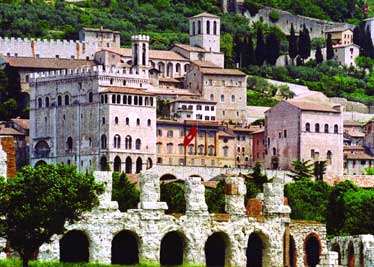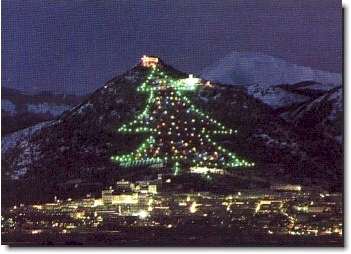|
 Laying
on the slopes of Monte Ingino, Gubbio is one of the most ancient towns
of Umbria, extremely well preserved during centuries and rich of
monuments testifying its glorious past. Laying
on the slopes of Monte Ingino, Gubbio is one of the most ancient towns
of Umbria, extremely well preserved during centuries and rich of
monuments testifying its glorious past.
Two important witnesses of the past are the Tavole Eugubine, one of
most important documents referring to the ancient people called
Italici and the Roman Theatre just outside the walls of the town.
Dominated from the top by the Basilica on which the rests of St.
Ubaldo are buried, Gubbio keeps architectonic masterpieces testifying
the beauty and the imprtance of what used to be during the Middle ages,
a real town-state.
At the beginning of the XIV century the Consuls Palace, today symbol
of the town, was constructed together with the square Piazza Pensile
and Pretorio Palace. To remind the palaces Beni, del Bargello with the
famous fountain, of People Captain , in typical renaissance style,
Dukes Palace by Francesco Giorgio Martini which testity the importance
of the period on which the Montefeltro's family had the administration
of the town.

Very interesting are also the Cathedral (XII century), St. Maria Nuova
(inside which one can admire the Madonna del Belvedere painted by
Ottaviano Nelli on 1413), Church and Convent of St. Agostino (XIII
century ) with inside frescoes of Nelli, Church and Convent of St.
Francesco (XIII century), St. Giovanni (XII century) characterised by
the facade and bell tower in romanic style, St. Peter enlarged in 1505
and St. Domenico enlarged in the XIV century.
Among the most important manifestations taking place in the city we
should absolutely mention the Racing silk of the Crossbow and the Ceri
Race.
|